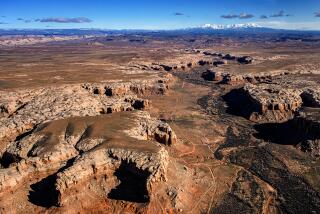America’s First Wilderness : The Catskills: History, Romance and Beauty
- Share via
ARKVILLE, N.Y. — The Catskills do not inspire the kind of awe associated with the majestic Rockies, the towering Grand Tetons of Wyoming, or even the remote and rugged Adirondacks of New York State.
In fact, “the Catskills aren’t really mountains at all,” said Edward West, who’s spent much of his 84 years tramping the Catskill ridges and woodlands around his Phoenecia home. “They’re just a plateau worn down.”
But what the Catskills lack in ruggedness or size, they make up for in history, romance, ethnic character and gentle, undulating beauty.
The Catskills could be called America’s first wilderness. Dutch explorer Henry Hudson first sighted their uneven eastern profile shimmering blue-gray in September haze as he sailed the Half Moon up the river that bears his name in 1609.
The mountains, within 100 miles of Manhattan, were ravaged by the builders of New York City, who sought stone for sidewalks, pines and hardwoods for lumber, hemlock bark for tanneries.
The flinty soil was tilled by settlers with a variety of ethnic backgrounds, which is reflected in nicknames given to resort towns in the northern Catskills: the “Italian Alps,” the “German Alps.”
The mountains were romanticized by writers and painters for an enchanted audience in the young nation and abroad.
“You know the Cattskills, lad,” says Natty Bumppo in James Fenimore Cooper’s “The Pioneers,” “you must have seen them on your left, as you followed the river up from York, looking as blue as a piece of clear sky, and holding the clouds on their tops.”
Washington Irving, who viewed the Catskills from the deck of a Hudson river sloop, chose the mountains as the setting of one of his most famous tales, as one is reminded today by the ubiquitous Rip van Winkle diners and shops.
Bumppo spoke of seeing “all creation” from atop a Catskill plateau known as South Mountain; in 1824, a magnificent colonaded resort known as the Catskill Mountain House was built there, and the Catskills became the fashionable place to go for fresh air, fine scenery and communion with nature.
Thomas Cole and other artists--later known collectively as the Hudson River School--went to the Mountain House, the nation’s first mountain hotel, and painted lavish scenes of wild gorges and mountains in glowing hues of gold, russet and violet.
Around the turn of the century, a man named Theodore Gordon studied the insects on which the local trout were feeding and fashioned a suitable fly for fishing on the Beaverkill and Willowemoc--two of the world-famous trout streams in the Catskills, birthplace of American fly fishing.
In the first half of the 20th Century, people, predominantly Jewish, flocked to more than 500 hotels and boardinghouses in the southern Catskills of Sullivan County--the Borscht Belt, where stand-up comics like Jerry Lewis, Alan King and Buddy Hackett got their start.
Only 32 resorts remain; many of the smaller ones are boarded up, with saplings growing in empty swimming pools. The survivors are mainly the giants like Grossingers, Kutshers, the Concord--grand full-service hotels with nightly entertainment, luxuriant golf courses, indoor and outdoor pools and tennis courts, ski slopes, and social directors to schedule non-stop family activities.
While the Catskills are well-known for their resorts and their image in paintings and prose, they are perhaps less known for being part of one of the nation’s most strongly protected wilderness areas: the New York State Forest Preserve.
In celebrations this year of the centennial of the Forest Preserve law, which declares that all lands owned or hereafter acquired by the state in the 12 Adirondack counties and four Catskill counties shall be kept “forever wild,” most of the emphasis has been on the Adirondacks.
Lacks Strong Identity
That’s partly because the Adirondacks include 2.5 million acres of Forest Preserve, compared to only about 272,000 acres in the Catskills. But it’s also partly because the Catskills lack a strong identity as a wilderness region, says Tom Miner, director of the nonprofit Catskill Center for Conservation and Development in Arkville, along the East Branch of the Delaware River.
A drive through the Catskills, shows patches of dense forest; stretches of rushing, stony rivers; honky-tonk ski towns filled with imitation Swiss chalets; tumble-down farmhouses with boards and vines over the windows; tarpaper shacks surrounded by discarded tires and the rusting guts of washing machines; stately mansions and A-frame cabins overlooking sweeping valleys.
Rounded mountains, including 35 higher than 3,500 feet, rise from flat-bottom valleys divided by stone walls and hedgerows. Waterfalls cascade over shelves of red sandstone in hemlock-lined gorges to feed the great reservoirs that supply New York City’s water.
But a land-sale boom has caused problems for communities unprepared to handle it. While the Adirondacks are protected from hodgepodge development of private land by the strict regulations of the Adirondack Park Agency, Catskill residents resisted such a regional zoning agency and in many cases have resisted local planning laws as well.
“Land! Country Homes, Cabins, Farms, Estates,” say billboards along Catskill highways. City dwellers with dreams of a mountain retreat have bought land only to find no access route, no utility hookups, terrain too steep or swampy to build on, soil too thin for a septic system, or no supply of water.
More to Read
Sign up for The Wild
We’ll help you find the best places to hike, bike and run, as well as the perfect silent spots for meditation and yoga.
You may occasionally receive promotional content from the Los Angeles Times.






